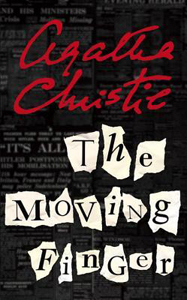“The Moving Finger” (1943) is not the deepest Agatha Christie novel. But it might intrigue fans of more recent teen fare such as “She’s All That” (1999) and “Gossip Girl” (2007-12). The story shows how gossip can drive people’s behavior, and also how a young woman’s confidence can change with a makeover.
Small-town talk
It’s not a particularly original work, though. We focus on two outsiders, siblings who rent a cottage in a small village on the classic old-school doctor’s advice of “get some fresh air.” The narrator, Jerry, is healing from a car accident, and sister Joanna is looking after him.
Like a more-mobile answer to Jimmy Stewart in “Rear Window,” Jerry takes an interest in the townspeople.

“The Moving Finger” (1943)
Author: Agatha Christie
Series: Miss Marple No. 3
Genre: Mystery
Settings: Lymstock, United Kingdom, 1943
Of particular interest to him is Megan, who somehow goes from being horse-like to being the object of his love. It’s quite similar to “Murder is Easy”: a natural, simplistic, but enjoyable version of how a love match could go.
The mystery, at least at first, is of a rather laid-back variety. Indeed, the police investigator notes multiple times that they’ll catch the anonymous letter-writer eventually; it’s just a matter of procedure.
The culprit sends notes to almost everyone in town, accusing them of a scandal that would be tame today – someone’s child isn’t their biological child, that sort of thing. And the accusations aren’t true anyway.
Minimum Miss Marple
Some readers will be disappointed that Miss Marple barely factors into the tale. She doesn’t appear until well over the halfway point, and arguably she’s not even needed. Marple gives the typical, modesty-laced explanation of human behavior at the end.
It might’ve been nice if Christie let Jerry have a small victory and solve the case himself. Marple notes that Jerry makes the right observations, and merely needed to take the next step to the answers.
The author gives us a broad lesson in misdirection in “The Moving Finger.” (The title comes from a poem, but it can also apply to an accusatory mood in a small town, where people are quick to point fingers based on scant evidence.)
I admit I didn’t solve the case, but the solution is wholly logical and backed up by clues. As always, we must sift out what’s important from what isn’t.
Light in tone
Despite featuring one gruesome murder, “The Moving Finger” is consistently light in tone, with a colorful cast of characters, most of whom could’ve used more development.
The Jerry-Megan tale is cute, but the story of Joanna pursuing the local doctor plays in the margins. Our narrator picks up snatches of that romance tale here and there.

You’ll probably forget about Jerry as a character and the solution to whodunit soon after putting this one down. Christie portrays self-confidence (via Megan) and the nature of small-town gossip with degrees of accuracy, but doesn’t provide new insight.
Still, even a throwaway Christie novel is better than elite work from lesser writers. “The Moving Finger” will engage readers as they let it wash over them in a few sittings.
Every week, Sleuthing Sunday reviews an Agatha Christie book or adaptation. Click here to visit our Agatha Christie Zone.

